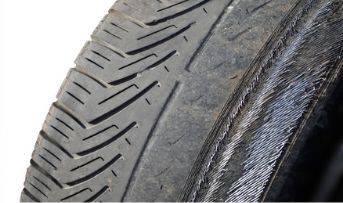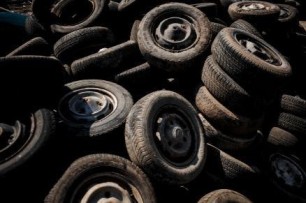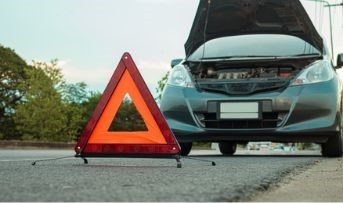General Insurance Blogs, Articles & Updates by - Magma HDI
Have us call you
- RENEW YOUR POLICY
- BUY NEW POLICY

Motorcyclists, here’s why you must invest in high-visibility clothing
The highway road accident rates in India are extremely concerning. Considering the majority of motorcyclists on roads makes this issue more serious. While 2 wheeler insurance online is an excellent safeguard, one must also consider active preventive actions. High-visibility clothing for motorcyclists is a game-changer. These specially designed clothing come in bright colours, making the rider stand out from the crowd even from a distance.
Motorcyclists may wear a half-jacket of colours, such as neon green or orange, with luminescent reflective strips on their torso. They may also wear a full jacket with reflective strips and cool design patterns.
High-visibility clothing is practical protective gear as one cannot miss the motorcyclist from a distance, and he becomes visible to others even in the dark.
Let us see the reasons why you should invest in high-visibility clothing.
1. Safety
Investing in high-visibility clothing increases your safety and may even save your life by preventing fatal accidents. Most bike accidents happen because the motorcyclist is not visible from a distance in the dark. Also, motorcyclists ride at high speeds on the highways, which makes them more susceptible to deadly accidents at sharp turns or on dark patches of the road.
High-visibility jackets have reflective patches, strips, or piping on shoulders and arms, which shines when the beaming headlight of vehicles coming from the front falls on it. This is extremely helpful when the streets are dark, making the rider visible and preventing untoward incidents.
2. Style
High-visibility clothing is not just important for the motorcyclist’s safety, but it looks cool and trendy as well. Bikers can make a style statement by investing in bright and fancy high-visibility clothing. Such clothes come in attractive colours. Some may contain intricate designing with the help of reflective patches, strips, or piping. This can make your jacket or vest look very stylish.
3. Ease of use
High-visibility clothing can come in several formats. The simplest and easiest clothing to use will be in the form of a vest. You just have to wear it over your shirt or t-shirt and take it off after you reach your destination. They are usually light and can be folded and packed easily.
4. Protection against harsh weather conditions
You can invest in high-visibility jackets that protect you from the harsh winter chill while riding. Such jackets can also be waterproof and protect you from the rain. Similarly, buy high-visibility gloves that protect your hands from the chilly weather and avoid direct impact on your hands during mishaps.
5. Durable
High-visibility clothing differs from the material you use to make your regular apparel. They can be made from polyester, spandex, retroreflective, and fluorescent-dyed materials. These materials are lightweight and stretchable, making them very comfortable for motorcyclists. They do not get spoiled or torn easily.
You should always invest in high-visibility clothing if you are a motorcycling enthusiast. They uplift your style quotient and act as information providers on the streets that you are approaching.
Apart from investing in high-visibility clothing, research for comprehensive 2 wheeler insurance online for your bike. It will protect you from financial suffering in theft, damage, or accident. Consider purchasing 2 wheeler insurance online in just a few clicks without visiting any insurance office.
Click HERE to buy 2 wheeler insurance online.
Disclaimer: The information provided above is for illustrative purposes only. To get more details, please refer to policy wordings and prospectus before purchasing a policy.

Simplifying commonly used insurance jargon
While checking any insurance plan, you most likely come across terms like deductibles, premiums, adjuster, etc. If you're unfamiliar with them, you may be confused and make wrong financial decisions.
It is now a given that everyone needs to have basic knowledge of terms relevant to general insurance. If not, you will find it daunting to buy insurance or apply for one. In such a case, it is extremely easy to get tricked. You will likely fall into the trap of fraudsters who can get more money from your lack of awareness and appropriate knowledge. Not knowing things can make the job easier for them.
If you need help understanding a few commonly used insurance jargon, this article is for you. This article will walk you through the various essential terms related to insurance. Prepare to dive into the world of simplified general insurance jargon that aids in making better financial decisions and equips you to help your peers and share your knowledge!
1. Claim:
This is one of the most important terms related to insurance used in all policies, including non-general and general insurance. A claim refers to the compensation or coverage of an incurred loss. It is a request to the insurance company to compensate you in cash or in kind for the loss you have encountered. It can be filed in case of a road accident, robbery, or even a natural disaster.
2. Adjuster:
An insurance company employs an adjuster to settle various claims. They investigate, examine, and evaluate before finalising any claim. The adjuster investigates all the crucial concerns. Be it the cause of loss, insurance coverage, the value of the loss, the amount of loss, and so on. Only after the adjuster adequately investigates everything the insurance company settles the claim.
3. Peril:
As the name suggests, this refers to a potential threat or danger that puts the insured at risk. It can also put an insured item or property at risk. It can be due to any irreversible causes and out of control. For instance, theft, fire, floods, and so on.
4. Deductibles:
This refers to the money to be paid by the insured for insurance coverage before the insurance company starts paying for the insurance policy. This amount is generally deducted from the claim before it is handed over to the insured.
5. Premium:
This refers to the amount paid to the insurance company to secure you against any damages or losses. It is a variable amount that depends on many factors while buying insurance.
6. Liability coverage:
As the name suggests, it protects the insured against any claim raised towards the damages and injuries caused to third parties or property.
7. Nominee:
This refers to a person entitled to receive the insurance claim if the insured dies. The insurance company redirects the claim to the rightful nominee declared by the insured as per the terms and conditions of the policy. They are generally the dependent, your spouse, child, parents, etc.
8. Waiting period:
This is the time that a policyholder has to wait before applying for a claim. Depending on various factors, the policy's terms & conditions, it can range from a few months to a few years.
With general insurance becoming necessary to protect your highly-valued assets and your finances, everyone must understand basic insurance jargon before evaluating and comparing policies. Only when you are aware of the basic terms can you buy the best insurance for yourself! Keep yourself aligned with the advancements of the insurance sector and buy general insurance online to get better offers and attractive premiums that account for efficient coverage.
Click HERE to buy general insurance online.
Disclaimer: The information provided above is for illustrative purposes only. To get more details, please refer to policy wordings and prospectus before purchasing a policy.

All you need to know about worn-out tyre treads
Tyres are crucial to forming a bond between the ground and the vehicle. They bear the brunt of weather conditions such as rain, heat, snow, etc. However, taking care of your vehicle's tyres is crucial for your safety and high performance. While purchasing motor insurance India provides a safety net in case of accidents, one must always prudently pay attention to the proper maintenance of essential components.
All you have to do is thoroughly check the physical conditions of the tyres to identify the issues. This comprehensive guide will help you examine your tyre treads and offer care tips.
What are tyre treads?
Tyre treads are a collection of grooves that run around the exterior. They help maintain a good grip on the road and to maximise traction on wet roads by dispersing water out of the way. Tyre grooves are essential for vehicle performance and safety.
Why do tyre treads wear out?
A tyre is made of rubber compounds that wear down with time. These include temperature, climate, the vehicle's mechanical condition, the road surface's roughness, tyre pressure, maintenance, etc. When the tyre wears down, it reduces the tread depth, resulting in a lack of grip. Thus, worn-out impressions are unsafe for driving, and you must replace them to reduce the risk of accidents.
Why are worn-out tyre treads dangerous?
Vehicle tyres wear out over time and with regular usage, resulting in losing tyre traction. However, nothing is riskier than driving with worn-out tyres. Here are some reasons to help you understand the risk associated with worn tyres.
1. High probability of puncture
When a tyre is half worn out, it can easily be eroded and cause a puncture anytime. This is a high-risk factor, especially when running your car over sharp-edged debris. An unexpected flat tyre in the middle of a journey can cause a single-vehicle collision. As a precaution and to avoid financial worries related to accidents, always purchase motor insurance India.
2. Tyres can overheat
Worn-out tyres have minimal tread left, causing relatively more heat build-up than a tyre with a good tread depth.
3. Increased risk of tyre burst
The risk of sudden blow-out increases while driving without adequate tread depth. Insufficient treads accumulate heat due to constant friction, causing them to burst.
4. Risk of hydroplaning
Tyre treads are well-developed to prevent hydroplaning. However, half-worn grooves make water shifting from under the tyre difficult. This can result in the vehicle sliding through water and losing its traction.
Ways to check the tyre treads
Checking your vehicle's tyres can eliminate road accidents. Here are some steps to inspect your tyres:
1. Examine tread depth
Every vehicle tyre has a certain amount of tread depth after regular usage. Over time, imprints wear down to a minimum acceptable level. When you lose that depth of the tread, its stability and grip get compromised. You must ensure the tread depth is above 1.6 mm for safe driving.
2. Examine sidewall
The sidewall of the tyre is adjacent to the treads. Bend down to check the cracks and cuts at the sidewalls. Check for any bulges. They can be a sign of internal damage, and if you find any, replace your tyre immediately.
3. Examine for uneven wear
Uneven tyres can occur for various reasons, including careless driving, imbalanced wheels, problematic suspensions, etc. You can prevent uneven wear by routinely checking the tyres. Do not overlook any signs. If you feel something off while driving, visit your car's service centre or a local garage.
Besides daily car use, adverse and harsh weather conditions can degrade the tyre's quality, affecting its safety and performance. You must repair or replace your tyre immediately if you spot any issues. Remember to buy the best motor insurance India policy to shield you from damages caused to the car if it encounters any accident.
Click HERE to buy the best motor insurance India policy.
Disclaimer: The information provided above is for illustrative purposes only. To get more details, please refer to policy wordings and prospectus before purchasing a policy.

Confused about purchasing health insurance for a rare condition? Here’s a quick guide
Health is one of the best gifts that one can have. You need to safeguard and protect your health at all times. You might always wish to avoid diseases and adapt to a healthy lifestyle. But unfortunately, you might be diagnosed with illnesses beyond your control. One such disease refers to a rare condition.
The World Health Organization (WHO) states few people suffer from this condition. It affects one person per 1000 individuals in the world. These rare diseases are usually genetic. They are mostly innate and present right from childhood.
Rare diseases can be fatal. They can get worse if the treatment is not provided on time. Usually, treating such rare diseases is expensive and possible only at limited hospitals. Having health insurance will aid you in covering all the costs. But does it cover your rare condition? To find out, read on!
Also, remember you should always renew health insurance online on time before it expires. If you do not, you can lose access to the basic facilities of your health insurance.
What are some common rare conditions? You may find it difficult to understand if your disease comes under a rare disease or not. To help you, we have listed some of the most common rare conditions. They are as follows:
● Sickle Cell Anemia
● Gaucher Disease
● Hurler Syndrome
● Cystic Fibrosis
● Maple Syrup Urine Disease
● Haemangioma
● Tyrosinemia
● Haemophilia
● Osteopetrosis
● Wolman Disease
Are rare conditions covered under health insurance in India?
Yes, many insurance companies in India do cover rare conditions. Regardless of the disease's cause, symptoms, and status, these rare conditions are covered by health insurance companies. The treatment expenses are thoroughly covered under the insurance policies. The right policy will provide you compensation for all the medical expenses. Be it surgery costs, medicines, diagnostic tests, hospitalisation fees, therapy, and post-surgery care, among others. It also covers daycare treatments if they are valid.
However, all this can be done only if you apply and opt for the best insurance policy for yourself. They should cover all the costs. It generally depends upon your budget. Mostly these insurance covers come with a high premium to make up for the costs.
The coverage of rare health conditions can vary from one insurance company to another. You must thoroughly check the list of rare conditions before signing up for any of this insurance. Visit the websites of different companies and check for online reviews before buying. You should also check the premium before investing.
What is the waiting period for health insurance coverage for rare conditions?
Generally, you need to wait for at least 30 days for any health insurance plan to provide adequate coverage. But the scenario is completely different in terms of rare conditions. You may need to wait at least 2 years to get the benefits of the health insurance you have opted for. It is because the coverage is mostly larger than other insurance. This also means the insurance will be renewed twice before you get any compensation. You should renew health insurance online and prepare in advance to get the compensation.
You must develop a habit of getting regular full-body check-ups to detect any abnormalities in advance. Do not ignore persistent symptoms. Consult your doctor if you feel sick. Dealing with a rare condition is already tough. Without proper health insurance, the battle can be extremely difficult. You should opt for the most suitable insurance to get adequate benefits when required. This way, you can avoid financial stress and focus on your health, treatment, and recovery.
Click HERE to renew health insurance online.
Disclaimer: The information provided above is for illustrative purposes only. To get more details, please refer to policy wordings and prospectus before purchasing a policy.

Know if it is worth buying used wheels or not
The tyres and wheels of your car are one of the most used external parts. They sometimes outperform their original capacity resulting in wear and tear due to rough surfaces. If left unnoticed, this can risk the safety of the passengers. So, you must ensure that your tyres are up to the standards as per the regulations set by the manufacturer, the road safety department, and the respective car company.
But what happens if you are facing issues with just one wheel? Do you have to go through the process of replacing all your wheels with new ones? What factors should you be watchful about, and how can you procure used wheels? Don't worry. At the end of this blog, you will know if it is worth buying used wheels or not. So, let's get started.
1. Why do we think it can be worth buying used wheels:
Purchasing used wheels is a good option if your four-wheelers have damaged wheels. This is a significantly cheaper and temporary option than buying a new set of wheels. You can comfortably use those used wheels without burning a hole in your pocket.
2. Understanding the quality of used wheels:
It would be best if you examined the used wheels closely. Be aware of all the cracks, dents, bends, or if any parts and pieces are missing. Surficial damages which are not causing any defects internally can be ignored. There might be issues with the structure of the wheels and rims, which can risk a puncture or blowout on uneven roads and at high speeds.
You can go to a junkyard where they sell used parts. But if you want to avoid the hassle and get quality used wheels and other components, visit an auto parts store that can provide you with top-quality used wheels.
3. Examining the used wheels for damages and defects:
A thorough visual examination is one of the best ways to determine the quality of the used wheels. The second solution is to take a test drive with those wheels. But there are situations where you might not be able to take a test drive, miss out on certain damages, or fail to understand the gravity of what might seem to be surficial damages. You should know other ways to inspect those used wheels in such cases.
If the wheel's outer rim has visible cracks, bends, or dents, it is more likely to get damaged, which might eventually cause a flat tyre. Examine the wheel for corrosion, rust, chipped paint, etc. Used wheels with improper or defective bolt holes should be immediately rejected. Test the wheel by rolling them on an even surface and avoid using them if you see any wobble, misaligned or sideways movement. This usually happens when the wheel is bent but could be difficult to notice during a visual examination.
4. Check the material:
Steel works quite well but affects the car's speed and acceleration since the material is heavy. People often use alloy rims as they are considered a good combination. It upgrades the look of your vehicle to give it a more sporty vibe, gives you a better driving experience, and eventually, helps you save fuel and money. You need to check the tyres' material and immediately reject used wheels with slight damage, corrosion, or rust.
Now you know if it is worth buying used wheels or not. And while we are considering wheels and their alternatives, a sudden accident or ending up in unfortunate circumstances can cause severe damage to your car. Getting those defects fixed can cause a substantial financial burden in times of distress. You need to purchase car insurance which would help you cover the massive costs of fixing and repairing in complex cases. You must explore all your options and buy reliable car insurance India with a reasonable premium and the best benefits.
Click HERE to learn more about the benefits of car insurance India.
Disclaimer: The information provided above is for illustrative purposes only. To get more details, please refer to policy wordings and prospectus before purchasing a policy.

Dealing with a car breakdown? Here’s what you should do
Imagine going on an outstation vacation in your car with your spouse and kids, and your car breaks down midway. You come to an abrupt halt, worried and looking for immediate help to safely get you back to your home or desired destination. Things can be worse when your car breaks down in an emergency.
A car breakdown is always a stressful and harrowing experience. It can be disturbing, especially when you are on a highway. It can leave you helpless and stranded, with usually no assistance in sight for a long distance.
Does this thought scare you? Fret not! Let us go through a few steps you must follow while dealing with a car breakdown. By implementing them, you can rescue yourself from the chaotic situation safely.
1. Pull off the road
If you feel that your car is taking jerks, or is not responding to acceleration or braking, immediately try to pull your vehicle to the side of the road, away from the running traffic. Do the same if you see smoke from the bonnet or inside your car.
Pulling on the side will ensure you are not stuck in the middle of the road with a broken car. It will provide you with some space to look into the breakdown and get it repaired. Also, it is the best action for your safety and your co-passengers.
2. Put on the emergency brakes
Put on the parking or emergency brake when your car is stationary on the side of the road. This will prevent your vehicle from moving forward or backward while repairing it. Be extra careful while parking your car on a hill or a slope. You should turn the steering, so the wheels turn away from the road. Place some bricks or a similar barrier to prevent your car from rolling forward or backward.
3. Switch on your hazard lights
As soon as you have pulled up on the sides, switch on your car's hazard lights. The vehicles approaching the road will know you are stationary and will not line up behind you.
Turning on the hazard lights is extremely important if your car has broken down on a highway. There may not be proper streetlights, and the other vehicles on highways move at high speed, causing a risky situation for you. The hazard lights will announce your stationary position on the road.
4. Use reflective triangles
Your car has reflective triangles in the back for such emergency use. Take them out and keep them at the back or sides of your vehicle. This will make your car visible in the dark and alert the moving traffic.
5. Look for an assistance
After ensuring that you and your car are safe, call the Roadside Assistance number. If you have bought an RSA membership plan, the company will send help to you immediately. You can contact any paid RSA service providers who will also tow your car to the nearest service station for some charges. You can also look for a good car mechanic nearby, ask for his help and get your car started if the glitch is minor. This can be a time-saving and simple solution.
A car breakdown can happen anywhere, anytime, and with anyone. Hence, we should always be mentally prepared for it and take action accordingly. Getting nervous and making hasty decisions can worsen your situation rather than improve it.
You can buy a roadside assistance top-up along with your motor insurance policy which can be immensely helpful in such situations. Choose the motor insurance company that can provide reliable services at the most economical cost and stay tension-free on your drives. Lastly, thoroughly service your car before planning a long-distance journey.
Click HERE to buy coverage from the best motor insurance company.
Disclaimer: The information provided above is for illustrative purposes only. To get more details, please refer to policy wordings and prospectus before purchasing a policy.

Single mother: A health insurance can secure your and your child’s future
Women have surpassed their traditional gender roles and are now leading huge organisations, establishing their start-ups, investing for their future, taking care of their families, and when they decide to become mothers according to their own choices. While we all know how society functions and several stereotypes have been crumbled to the ground by women, we are still far from creating a safer space. But there is no second thought about how the position of women in society has improved over time.
Due to unfortunate circumstances or by choice of living a stress-free life, several women are single mothers today. And most of them hold sole custody of their kid(s). Again, the stigma against single parenting is quite challenging to go through. There are several aspects to ensuring you create a happy life for yourself and your kid. This blog aims to make single mothers understand the importance of health insurance and how it can secure their future and their child’s upbringing. Here’s a guide to achieving that and all you need to know about the topic.
1. Explore all your options.
There are several insurance options in the market. You will see a herd of insurance providers. It would be best to thoroughly research every health insurance- the merits and demerits, terms and conditions, renewal policy, sum insured, service quality, hospitals in the network, trust, and ratings. After all these detailings, if you still feel the process is overwhelming and you cannot differentiate amongst the integral factors, you can consult a financial expert who will help you prioritise your needs and put forth the best options for you.
2. How do you prioritise your requirements?
Health insurance should be at the top of your priority list. And while the details of various types of insurance available in the market can be overwhelming, you need to prioritise your requirements. How can you do that? You need to figure out your insurance coverage, keeping in mind the range of medical expenditures in your location, as geographical factors influence hospital expenses.
While determining the amount for coverage for your health insurance, you need to be careful about the limitations like the hospital expenses, the settlement for the claims regarding the ailments, etc. Health insurance with these restrictions tends to cost you lower than those who endorse full coverage. Listing your needs will help you find the perfect insurance for your necessities.
3. Plan ahead of time.
As a single mother, you have a massive load of responsibilities on your shoulders. It would be best if you secure your future and your child’s/children’s and family’s future from an early stage. Also, you will see a significant increase in medical inflation, impacting health insurance premiums, hospitalisation costs, prices of medical aids and equipment, etc. To combat the unpredictability of this journey called life, you will need to gear up.
You need to look for the additional benefits provided by the various insurance providers and the type of features these benefits carry, for example, daycare, expenditure of an attendant/caretaker, etc. You can explore and analyse the benefits you can get through different added features or insurance for critical illness.
We discussed the perks of health insurance for single mothers. But in no way is it limited to just single parents. Everyone out there requires health insurance to stay monetarily stress-free during difficult phases of life involving health troubles. And with technology, the hassle of buying and renewing insurance is just a matter of a few clicks now! You can purchase or renew health insurance online and be the master of your ship to choose what’s best for you and your family.
Click HERE to learn more about how to renew health insurance online.
Disclaimer: The information provided above is for illustrative purposes only. To get more details, please refer to policy wordings and prospectus before purchasing a policy.

Experiencing a burning sensation in your chest? You may be suffering from acid reflux
Most people may have experienced a burning sensation in their chest at least once. Associated with discomfort and heaviness, the feeling may not appear severe but can be life-threatening. Typically, it is a symptom of gastrointestinal issues and lung problems. Considering the frequency and ubiquitous occurrence of this issue, it becomes essential to buy health insurance online.
There are several reasons for the burning sensation, like stomach ulcers and panic attacks. The likelihood of experiencing a burning feeling in your chest can rise because of reduced blood flow and lung inflammation. But if you feel discomfort in your chest, consult your doctor as soon as possible because it can be related to other severe issues.
But did you know that acid reflux can also be a cause of experiencing discomfort in your chest? Acid reflux is caused by heartburn, a burning sensation mainly because of stomach acid. It can affect people of all ages. Hectic lifestyles and poor health management habits are the contributors to this condition. Many risk factors cause acid reflux, some of which can be serious. It may occur due to smoking, pregnancy, low physical exercise, obesity, etc.
Let's dive deeper to understand acid reflux.
Why does acid reflux happen?
The stomach contains hydrochloric acid, a chemical that reacts with the food and breaks it down. This helps in preventing bacterial growth in the stomach. The ring of the muscle usually acts as a valve that lets food to the stomach but does not back up into the oesophagus. If this valve fails, the stomach content regurgitates into the oesophagus, forming acid reflux. And by this, a person may feel a burning sensation in the chest.
What are the risk factors of acid reflux?
Sometimes, acid reflux happens for absolutely no reason. But there are several risk factors that you should know.
● Active smoking
● Low level of physical exercises
● Pregnancy
● Obesity
● Excessive consumption of caffeine
● Consuming spicy and fatty foods
● Drinking multiple acidic juices
● Eating fast foods
How does acid reflux feel?
Heartburn is the primary symptom of acid reflux. It's a horrific burning sensation that starts in the oesophagus and leads to discomfort in the chest too. It gets worse while lying down and can last for several hours. Sometimes, the stomach fluid can reach the back of the throat, producing a bitter taste and a disturbed peace of mind.
Symptoms of acid reflux
● Heartburn
● A sour, bitter taste in the mouth
● Bloating in the stomach
● Vomit with blood
● A feeling that fluid is stuck in your throat
● Nausea
● Constant weight loss
● Dry cough or sore throat
Causes of acid reflux
Several reasons cause acid reflux, some of which are:
● Eating larger meals at a time and immediately lying down
● Drinking a large amount of alcohol, caffeine, tea, or any acidic juices
● Eating citric foods such as tomatoes, mint, garlic, and spicy foods
● Pregnancy changes
Treatments for acid reflux
There are several ways to avoid acid reflux, including:
● Quit smoking
● Eat smaller meals throughout the day and modify your food types
● Try to sleep in a chair in the daytime for small naps
● Do not wear tight clothes
● Lose weight and change your diet
● Indulge in physical activity
If you have had an acid reflux problem for over a week, you must consult your doctor for medications. It may happen due to several lifestyle changes. It is a common concern but cannot be brushed off, as it may be life-threatening sometimes. In mild cases, simple medicines may resolve your issue. However, for recurring problems, doctors may recommend surgery to cure acid refluxes. Considering the increasing medical inflation and health-related expenses, it is essential to buy health insurance online for your safety against hospitalisation expenses.
Click HERE to buy health insurance online.
Disclaimer: The information provided above is for illustrative purposes only. To get more details, please refer to policy wordings and prospectus before purchasing a policy.


